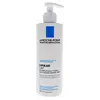Shea Moisture African Black Soap Bamboo Charcoal Detoxifying Foaming Facial Wash Versus La Roche-Posay Lipikar Lait Lipid-Replenishing Body Milk
What's inside
What's inside
 Key Ingredients
Key Ingredients

 Benefits
Benefits

 Concerns
Concerns

 Ingredients Side-by-side
Ingredients Side-by-side

Water
Skin ConditioningDecyl Glucoside
CleansingCocamidopropyl Betaine
CleansingGlycerin
HumectantDicaprylyl Ether
EmollientSodium PCA
HumectantGlyceryl Oleate
EmollientPanthenol
Skin ConditioningButyrospermum Parkii Butter
Skin ConditioningTamarindus Indica Fruit Extract
Skin ConditioningCharcoal Powder
AbrasiveAllantoin
Skin ConditioningMenthol
MaskingMelaleuca Alternifolia Leaf Oil
AntioxidantGuar Hydroxypropyltrimonium Chloride
Skin ConditioningTocopherol
AntioxidantParfum
MaskingSodium Palm Kernelate
CleansingSodium Shea Butterate
CleansingSodium Cocoate
CleansingTheobroma Cacao Husk
AbrasiveCaprylhydroxamic Acid
Triethyl Citrate
MaskingBenzoic Acid
MaskingWater, Decyl Glucoside, Cocamidopropyl Betaine, Glycerin, Dicaprylyl Ether, Sodium PCA, Glyceryl Oleate, Panthenol, Butyrospermum Parkii Butter, Tamarindus Indica Fruit Extract, Charcoal Powder, Allantoin, Menthol, Melaleuca Alternifolia Leaf Oil, Guar Hydroxypropyltrimonium Chloride, Tocopherol, Parfum, Sodium Palm Kernelate, Sodium Shea Butterate, Sodium Cocoate, Theobroma Cacao Husk, Caprylhydroxamic Acid, Triethyl Citrate, Benzoic Acid
Water
Skin ConditioningButyrospermum Parkii Butter
Skin ConditioningGlycerin
HumectantSorbitan Stearate
EmulsifyingParaffinum Liquidum
EmollientNiacinamide
SmoothingBrassica Napus Seed Oil
EmollientAluminum Starch Octenylsuccinate
AbsorbentDimethicone
EmollientCera Alba
EmollientSorbitan Tristearate
EmulsifyingCarbomer
Emulsion StabilisingSodium Hydroxide
BufferingPoloxamer 338
EmulsifyingAmmonium Polyacryloyldimethyl Taurate
Emulsion StabilisingDisodium EDTA
Sucrose Cocoate
EmulsifyingCaprylyl Glycol
EmollientCitric Acid
BufferingT-Butyl Alcohol
PerfumingCetyl Palmitate
EmollientPentaerythrityl Tetra-Di-T-Butyl Hydroxyhydrocinnamate
AntioxidantChlorhexidine Digluconate
AntimicrobialParfum
MaskingWater, Butyrospermum Parkii Butter, Glycerin, Sorbitan Stearate, Paraffinum Liquidum, Niacinamide, Brassica Napus Seed Oil, Aluminum Starch Octenylsuccinate, Dimethicone, Cera Alba, Sorbitan Tristearate, Carbomer, Sodium Hydroxide, Poloxamer 338, Ammonium Polyacryloyldimethyl Taurate, Disodium EDTA, Sucrose Cocoate, Caprylyl Glycol, Citric Acid, T-Butyl Alcohol, Cetyl Palmitate, Pentaerythrityl Tetra-Di-T-Butyl Hydroxyhydrocinnamate, Chlorhexidine Digluconate, Parfum
Ingredients Explained
These ingredients are found in both products.
Ingredients higher up in an ingredient list are typically present in a larger amount.
This ingredient is also known as shea butter. It is an effective skin hydrator and emollient.
Emollients help soothe and soften your skin. It does this by creating a protective film on your skin. This barrier helps trap moisture and keeps your skin hydrated. Emollients may be effective at treating dry or itchy skin.
Shea butter is rich in antioxidants. Antioxidants help fight free-radicals, or molecules that may harm the body. It is also full of fatty acids including stearic acid and linoleic acid. These acids help replenish the skin and keep skin moisturized.
While Shea Butter has an SPF rating of about 3-4, it is not a sunscreen replacement.
Shea butter may not be fungal acne safe. We recommend speaking with a professional if you have any concerns.
Learn more about Butyrospermum Parkii ButterGlycerin is already naturally found in your skin. It helps moisturize and protect your skin.
A study from 2016 found glycerin to be more effective as a humectant than AHAs and hyaluronic acid.
As a humectant, it helps the skin stay hydrated by pulling moisture to your skin. The low molecular weight of glycerin allows it to pull moisture into the deeper layers of your skin.
Hydrated skin improves your skin barrier; Your skin barrier helps protect against irritants and bacteria.
Glycerin has also been found to have antimicrobial and antiviral properties. Due to these properties, glycerin is often used in wound and burn treatments.
In cosmetics, glycerin is usually derived from plants such as soybean or palm. However, it can also be sourced from animals, such as tallow or animal fat.
This ingredient is organic, colorless, odorless, and non-toxic.
Glycerin is the name for this ingredient in American English. British English uses Glycerol/Glycerine.
Learn more about GlycerinParfum is a catch-all term for an ingredient or more that is used to give a scent to products.
Also called "fragrance", this ingredient can be a blend of hundreds of chemicals or plant oils. This means every product with "fragrance" or "parfum" in the ingredients list is a different mixture.
For instance, Habanolide is a proprietary trade name for a specific aroma chemical. When used as a fragrance ingredient in cosmetics, most aroma chemicals fall under the broad labeling category of “FRAGRANCE” or “PARFUM” according to EU and US regulations.
The term 'parfum' or 'fragrance' is not regulated in many countries. In many cases, it is up to the brand to define this term.
For instance, many brands choose to label themselves as "fragrance-free" because they are not using synthetic fragrances. However, their products may still contain ingredients such as essential oils that are considered a fragrance by INCI standards.
One example is Calendula flower extract. Calendula is an essential oil that still imparts a scent or 'fragrance'.
Depending on the blend, the ingredients in the mixture can cause allergies and sensitivities on the skin. Some ingredients that are known EU allergens include linalool and citronellol.
Parfum can also be used to mask or cover an unpleasant scent.
The bottom line is: not all fragrances/parfum/ingredients are created equally. If you are worried about fragrances, we recommend taking a closer look at an ingredient. And of course, we always recommend speaking with a professional.
Learn more about ParfumWater. It's the most common cosmetic ingredient of all. You'll usually see it at the top of ingredient lists, meaning that it makes up the largest part of the product.
So why is it so popular? Water most often acts as a solvent - this means that it helps dissolve other ingredients into the formulation.
You'll also recognize water as that liquid we all need to stay alive. If you see this, drink a glass of water. Stay hydrated!
Learn more about Water